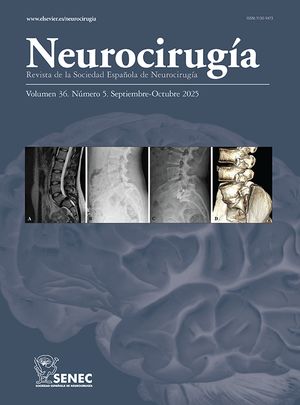Evaluar las complicaciones perioperatorias y a largo plazo en pacientes tratados mediante endarterectomía por estenosis carotídea en nuestro Servicio.
Pacientes y métodosEstudio retrospectivo de 97 endarterectomías realizadas por 6 neurocirujanos en 90 pacientes entre enero de 1995 y diciembre de 2003. Diez de los pacientes fueron mujeres. La mediana de edad fue 69 años (rango 38–86). Siete pacientes se intervinieron bilateralmente. Ochenta y cuatro estenosis fueron mayores del 70%. El número de cirugías anual por cirujano fue de 3 (rango 0–10). El seguimiento clínico fue de 121 días, (rango 8–2106).
ResultadosFallecieron 4 pacientes en el postoperatorio inmediato y otros 4 presentaron déficits neurológicos añadidos, con una morbimortalidad de 8’9% de los pacientes y 8’2% de las cirugías. Cuatro pacientes se reintervinieron, 1 por déficit neurológico inmediato y 3 por hematoma quirúrgico. Hubo afectación transitoria de nervio periférico en 8 pacientes y se registraron 21 complicaciones médicas asociadas. Posteriormente 7 pacientes fallecieron (6 por cáncer y 1 por cardiopatía) y 5 presentaron ictus (3 ipsilaterales y 2 de otra localización). En el último control postoperatorio por imagen, a los 52 (0–2832) días, se constataron 7 estenosis en la arteria operada.
ConclusionesLa endarterectomía carotídea puede realizarse con razonable seguridad en centros con bajo volumen de pacientes, con métodos sencillos y con resultados aceptables. El conocimiento de los resultados reales obtenidos en cada centro es importante para mejorarlos.
To assess perioperative and long-terco morbidity in patients diagnosed of carotid stenosis sub-mitted to our Department for surgical endarterectomy.
Patients and methodsA retrospective study of 97 endarterectomies performed by six neurosurgeons in 90 patients treated between january 1995 and december 2003. Ten patients were women. Average mean age was 69 years-old (range 38–86). Seven patients were treated bilateraly. Eighty-four stenosis were greater than 70%. Annual number of interventions per surgeon was 3 (range 0–10). The median follow-up was 121 days, (range 8–2106).
ResultsFour patients died perioperatively and another 4 developed new neurologic déficits. The combined morbiditymortality rate was 8’9% of the patients and 8’2% of the surgeries. Four patients needed rein-tervention, because of immediate postoperative new déficit (one) and surgical hematoma (three). Transient peripheral nerve palsy occurred in 8 patients and 21 medical complications were registered. In the long term, 7 patients died (6 because of cáncer and 1 because of cardiopathy) and 5 presented neurologic events (3 ipsilateral and 2 in other locations). Last postoperative image control, performed on average after 52 days (0–2832), revealed 7 estenosis of the treated artery.
ConclusionsCarotid endarterectomy can be safely performed in low-volume centers with acceptable results and reasonable morbidity and mortality rates when simple techniques are used. We consider crucial to evalúate self complications and results in order to improve them.
Artículo

Si es la primera vez que accede a la web puede obtener sus claves de acceso poniéndose en contacto con Elsevier España en suscripciones@elsevier.com o a través de su teléfono de Atención al Cliente 902 88 87 40 si llama desde territorio español o del +34 932 418 800 (de 9 a 18h., GMT + 1) si lo hace desde el extranjero.
Si ya tiene sus datos de acceso, clique aquí.
Si olvidó su clave de acceso puede recuperarla clicando aquí y seleccionando la opción "He olvidado mi contraseña".







